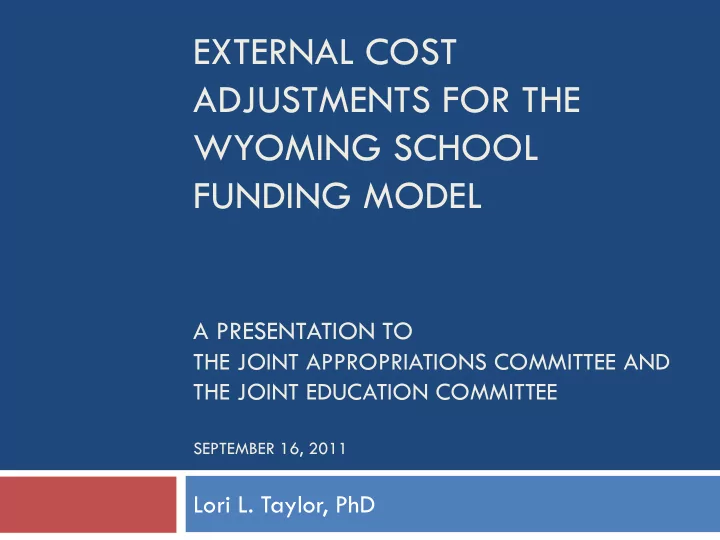

EXTERNAL COST ADJUSTMENTS FOR THE WYOMING SCHOOL FUNDING MODEL A PRESENTATION TO THE JOINT APPROPRIATIONS COMMITTEE AND THE JOINT EDUCATION COMMITTEE SEPTEMBER 16, 2011 Lori L. Taylor, PhD
The Need for Cost Adjustments 2 Picus and Associates have advised the Legislature about the real resources needed to provide “the basket” of educational goods and services every child in Wyoming should receive The price of those real resources changes over time Without cost adjustments, inflation could leave school districts unable to provide the necessary educational resources
Possible Cost Adjustments 3 There are a number of existing price indices that could be used to measure year-to-year changes in the cost of education The Consumer Price Index (CPI) The Wyoming Cost of Living Index (WCLI) The Employment Cost Index (ECI) The Comparable Wage Index (CWI) The U.S. Bureau of Economic Analysis (BEA) indices of educational costs (labor, energy and materials) None of them reflect all of the inflationary pressures facing Wyoming school districts in a timely manner
Designing External Cost Adjustments for Wyoming 4 Intuitively, the most appropriate ECA for Wyoming should reflect not only changes over time in the price of labor but also changes over time in the price of other important educational inputs Rather than applying one of the existing price indices to the cost basis of the funding model as a whole, Wyoming should consider adjusting each major resource component separately using the most appropriate cost index for each type of resource
The Four Major Cost Components 5 Professional labor (66.7%) Nonprofessional labor (14.6%) Energy ( 3.4%) Materials (15.3%)
Possible Labor Cost Indices 6 The ECI National level indices for salaries and/or benefits An ECI is available specifically for the elementary and secondary education industry ECIs for the education services industries may be unduly influenced by the policy choices of other states The CWI Wyoming-specific index available The CWI reflects only growth in the wages of non-educators Salary index only
The Cost Indices for Professional Labor 7 Index 2001=100 150 Wyoming Comparable Wage Index 140 National Comparable Wage Index Employment Cost Index, Elementary and 130 Secondary Education Employment Cost Index, All Workers 120 110 100 90 2001 2002 2003 2004 2005 2006 2007 2008 2009 2010
The Labor Cost Indices and Wyoming Teacher Salaries 8 Index 2001=100 170 Funding Model Salary Index 160 Actual Teacher Salary Index 150 Wyoming Comparable Wage 140 Index Employment Cost Index, 130 Elementary and Secondary Education 120 110 100 90 2001 2002 2003 2004 2005 2006 2007 2008 2009 2010
Cost Indices for Non-Professional Labor 9 Nonprofessional labor cost index based on new Comparable Wage Index for high school graduates (HS-CWI) HS-CWI estimated using same method as CWI, but different Census data Census data covers individuals with a high school diploma but not a bachelor’s degree Reflects growth in Wyoming wages for high school graduates
Cost Indices for Energy and Supplies 10 BEA indices only available through 2008 Bureau of Labor Statistics’ Producer Price Indices (PPI) much more timely BEA index for Education Sector Materials tracks PPI for Office Supplies and Accessories BEA index for Education Sector Energy tracks a weighted average of PPIs for commercial electricity and natural gas
Recommended Cost Indices for the Four Major Funding-Model Components 11 Index 2001=100 150 140 130 120 110 100 Professional Staff Nonprofessional Staff 90 Energy Educational Materials 80 2001 2002 2003 2004 2005 2006 2007 2008 2009 2010
Inflationary Pressures May be Higher in Wyoming than in the Nation as a Whole 12 Wyoming Cost of Living Index Wyoming HS-CWI Wyoming Average Fair Market Rents Wyoming Comparable Wage Index National Comparable Wage Index Employment Cost Index, Elementary and Secondary Education Employment Cost Index, All Workers Consumer Price Index Producer Price Index for Office Supplies Composite Energy Index -1.00% 0.00% 1.00% 2.00% 3.00% 4.00% 5.00% 6.00% 7.00% Annual Percentage Change in the Price Level, 2009-2010.
Looking Forward 13 All of the recommended indices indicate that the inflationary pressure on school districts has eased recently They also indicate that inflationary pressures may be greater in Wyoming than in most other states It is reasonable to anticipate that inflation will continue to impact the necessary funding allocations and plan accordingly
Important Caveats 14 Cost indices serve only to maintain the status quo. Their use presumes accurate baseline measures of resource costs If the baseline estimates overstate actual costs then applying a cost index would simply perpetuate the overfunding The most appropriate policy response could be to forgo applying a cost adjustment until costs and funding converge If a baseline estimate understates actual costs then applying a cost index would only perpetuate the underfunding Further action would be needed to ensure that districts are able to provide the necessary resources
Conclusions 15 External cost adjustments are an important part of school finance in Wyoming Labor cost indices give an incomplete picture of changes in educational cost Once funding levels become aligned with costs, Wyoming should consider adjusting each major resource component separately using the most appropriate cost index for that component
Thank you
Recommend
More recommend